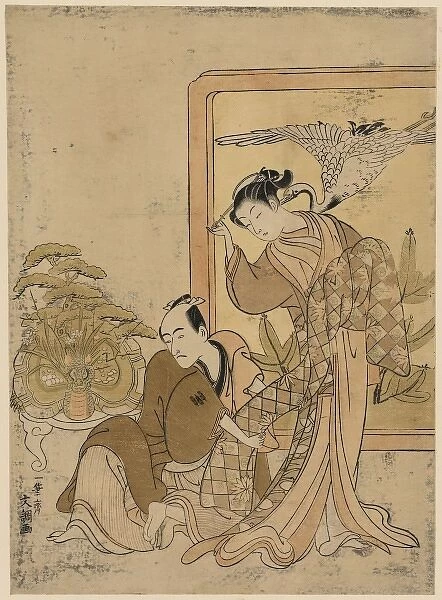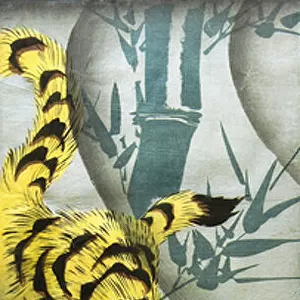Transformed armor pulling incident kusazuri biki
![]()

Wall Art and Photo Gifts from Mary Evans Picture Library
Transformed armor pulling incident kusazuri biki
Transformed armor pulling incident kusazuri biki. Print shows a man sitting on the floor clutching a long piece of cloth held by the woman standing next to him; she has her hand on a hairpin, perhaps getting ready to remove it. A screen painting behind the woman shows a crane in flight. Date 1769 or 1770
Mary Evans Picture Library makes available wonderful images created for people to enjoy over the centuries
Media ID 7359302
© Mary Evans Picture Library 2015 - https://copyrighthub.org/s0/hub1/creation/maryevans/MaryEvansPictureID/10603261
Armor Incident Pulling Transformed Woodblocks Woodcuts
EDITORS COMMENTS
1. Title: The Transformed Armor Pulling Incident (Kusazuri Biki) - A Tale of Love and Deception, 1769-1770 This woodblock print, titled "Kusazuri Biki" or "The Transformed Armor Pulling Incident," dates back to 1769 or 1770 in Japan. The intriguing scene unfolds as a man, dressed in a formal kimono, sits on the tatami mat floor with a long piece of cloth clutched in his hands. His expression is one of anxiety and apprehension, as if bracing himself for an imminent confrontation. The woman standing next to him, her back turned to the man, is poised and resolute. She holds a hairpin in her hand, her gaze fixed on the man, suggesting that she is about to remove the ornamental pin from his armor. The transformation of the armor, which is depicted in a screen painting behind her, hints at the significance of this moment. The title "Kusazuri Biki" refers to an ancient Japanese custom, where a woman would test the loyalty and devotion of her husband or lover by secretly removing a pin or ornament from their armor while they were away. If the man returned home without noticing the missing pin, it was considered a sign of his faithfulness. However, if he noticed and became angry, it could lead to a heated argument or even a violent confrontation. The crane in flight depicted in the screen painting symbolizes longevity and good fortune, adding an element of hope and optimism to the scene. The intricate details and expressive figures in this woodblock print demonstrate the masterful artistry of the ukiyo-e (floating world) genre, which flourished in Japan during the late Edo period. This print offers a glimpse into the complexities of Japanese culture and relationships during the 18th century, making it an invaluable piece of historical and artistic significance.
MADE IN THE USA
Safe Shipping with 30 Day Money Back Guarantee
FREE PERSONALISATION*
We are proud to offer a range of customisation features including Personalised Captions, Color Filters and Picture Zoom Tools
SECURE PAYMENTS
We happily accept a wide range of payment options so you can pay for the things you need in the way that is most convenient for you
* Options may vary by product and licensing agreement. Zoomed Pictures can be adjusted in the Cart.










